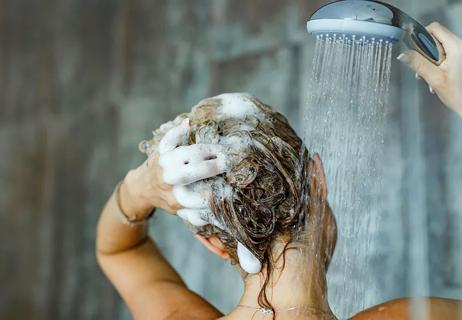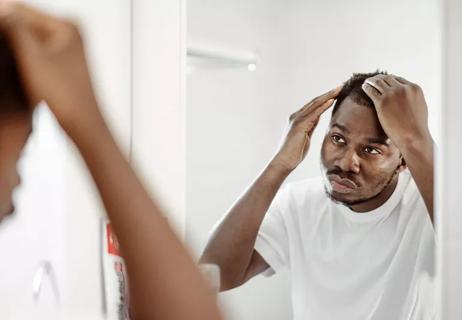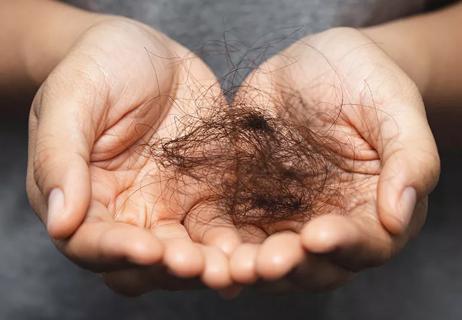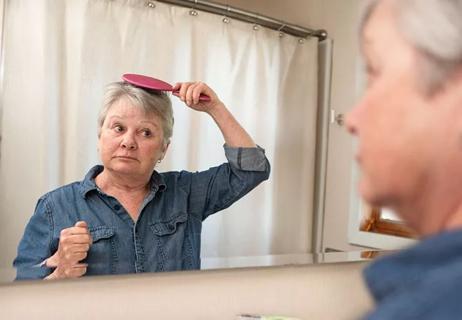Illnesses can lead to hair loss, but it doesn’t last forever

You’re lathering up your tresses in the shower, and it happens … your hair is coming out.
Advertisement
Cleveland Clinic is a non-profit academic medical center. Advertising on our site helps support our mission. We do not endorse non-Cleveland Clinic products or services. Policy
Hair loss and hair shedding can be the result of a number of conditions, including a recent COVID-19 infection.
To learn more about how COVID-19 can affect your locks, we spoke to dermatologist Shilpi Khetarpal, MD.
“At any given time, about 90% of our hair is growing, about 5% is resting and 5% is shedding,” Dr. Khetarpal says. “But when you have a major stress event, illness or shock, up to 50% of hairs can be pushed into the shedding phase.”
If you had COVID-19, Dr. Khetarpal says hair loss is a side effect you could see down the line. Unlike some hair loss conditions, shedding associated with COVID-19 and other illnesses doesn’t come with symptoms in your scalp, like redness, flaking, itching or burning.
Research studies have shown that a “significant percentage” of people who were infected with COVID-19 experienced some hair loss. In the study, COVID-19-associated telogen effluvium (excessive hair shedding) generally occurred one to two months following a COVID-19 infection.
One study says up to 60% of people infected with COVID-19 experience hair shedding.
“Whether we’re talking about COVID-19, the flu, strep throat — any kind of illness or fever can cause a change in the hair,” Dr. Khetarpal notes. That’s because when your body turns its attention to fighting off viruses or bacteria, it doesn’t put as much energy into things like hair growth. There are bigger fish to fry.
Advertisement
Other effects of COVID-19 infection can be associated with hair loss and hair shedding as well, including:
The stress of living in the COVID-19 pandemic can be enough to cause hair shedding for a lot of people. You don’t have to be sick to be affected, Dr. Khetarpal says.
“There’s a lot of stress associated with the pandemic,” she continues. “There are financial stressors and people have lost their jobs. Any kind of physical, emotional stress can also contribute to or cause shedding.”
And if you were already stressed before the pandemic? “That stress can compound on itself and make it worse,” she adds.
Some research has shown a loose connection between the COVID-19 vaccine and alopecia areata in a very small population of people who received COVID-19 vaccinations. The researchers are quick to point out, though, that the individuals studied may have already been at higher risk for alopecia.
Dr. Khetarpal also stresses that the overwhelming benefits of being vaccinated for COVID-19 strongly outweigh any potential hair loss concerns.
Most cases of hair shedding after COVID-19 resolve themselves within about two to six months, researchers report.
That’s a long time to lose hair, and it can lead to some additional emotional stress. When that stress builds on itself, it can lead to — yep — more hair shedding.
“There’s a huge cultural component to hair. It’s part of our identity and how people perceive us,” Dr. Khetarpal says. “When people start losing their hair, especially for the first time, it can be very emotionally distressing and upsetting to them.”
As disconcerting as it can be, Dr. Khetarpal says hair loss as a result of COVID-19 infection, stress or other causes is treatable.
“Those hairs that were shed are replaced with new, healthy hair,” she explains. “People might feel like their hair is thinner but, eventually, their hair density goes back to normal, assuming the hair loss isn’t from medication or a nutritional deficiency.”
Still, people who experience hair loss might be concerned about what’s happening and want to know what they can do to help curb it and get their hair growing back to normal. “Usually, I tell people to manage their stress,” Dr. Khetarpal says. “Obviously, there are things going on right now that we can’t control, but there are still steps we can take to try to keep our stress lower.”
Exercise, eating a well-balanced diet that includes a lot of protein and drinking enough water are ways to help combat hair shedding.
Advertisement
If the hair loss is severe or your hair isn’t coming back in like it should, there are other avenues you can explore with a healthcare provider.
Minoxidil is a topical solution or foam that can help regrow hair by being applied directly to your scalp. It works by pushing hair into the growing phase instead of resting or shedding. While there are several different forms in which you can acquire minoxidil, Rogaine® is probably the most well-known brand.
“It’s safe for most people,” Dr. Khetarpal says. “The only time we don’t recommend using it is during pregnancy or when you’re nursing.”
Besides a multivitamin, taking certain vitamin supplements can also help boost key nutrient levels that promote hair regrowth. One of these is biotin, a water-soluble B-vitamin. Three to five milligrams a day can help.
That extends to other vitamins, too. “If someone is deficient in vitamin D or iron, we know that their hair can shed. So, that’s why we say that with a multivitamin, you can make sure you’re getting enough nutrients that you need for your hair,” Dr. Khetarpal says.
There are additional options to restore your hair after COVID-19, too, including oral medications. Some people also benefit from a process by which platelets are taken from their plasma and injected into their scalp to boost hair regeneration. These options should be explored with the support of a healthcare provider.
Advertisement
“We start with the simplest things first,” Dr. Khetarpal says. “We’ll make sure you aren’t deficient in any nutrients or vitamins. Then, we might recommend minoxidil if you’re a candidate and move on from there. We start with those easy things and we can add things on.”
Advertisement
Learn more about our editorial process.
Advertisement

The endocrine gland in charge of hormone production may be causing your hair to shed or stop growing

They can’t treat the cause of your hair loss, but some ingredients are better than others

How often you should do it depends on various factors

Keep your hair on your head with these tips

This treatment can help those with cancer keep some of their hair

You can offset the effects of time, dyes and medications

The short answer from a dermatologist

The 411 on your shedding habit

Type 2 diabetes isn’t inevitable with these dietary changes

Applying a hot or cold compress can help with pain